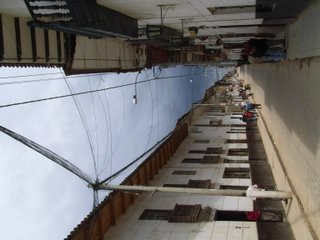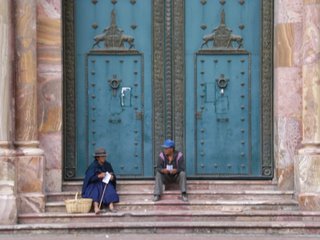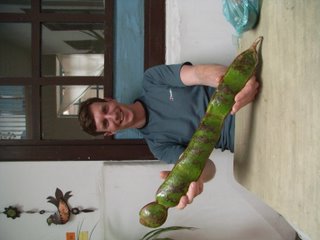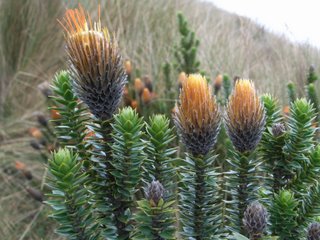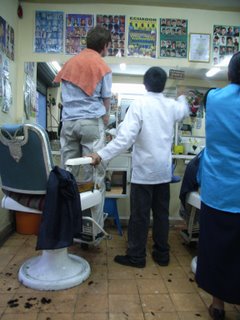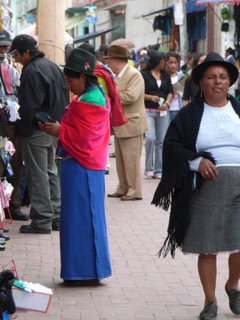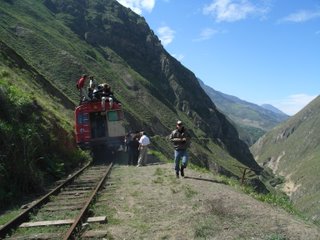This post is very long and is all about football. If this is not your thing and you are short of time then give it a miss!
We arrived at Hernando Siles Stadium in La Paz a little late, having wolfed down hurrieldy ordered food from the hotel. The taxi driver pointed across the sea of people to a place where we hoped the ticket office would be. We never made it there, buying tickets from a lady tout in a remarkably formal exchange that left me wanting to shake hands. We moved with the heaving crowd towards the turnstiles, small white squares of polystyrene foam the only things for sale. Closer to the gate pushing was the only way to move. There was a father protecting his baby nearby and while the baby slept soundly the squeeze tightened for the rest of us. Once inside there was space for everyone and we found a confectionary stall to swap 7 bolivianos and some bad spanish for a snickers and directions to our seats. Upstairs and anywhere seemed to be the gist of it.
We had met Ian (a Kiwi) at breakfast that day and talked about the possibility of watching football. I had spent all day checking the internet and asking locals to be met by lots of blank looks and "I don't think so's" so I was surprised when Ian showed me a fixture in the local paper. I was even more surprised to see the hordes of people at the stadium and to learn that the match was a local derby between Bolivia's two best teams and a qualifier for the Copa Del Sur.
The "Preferencia" area of the stadium where we were sitting was terraced concrete and we quickly found out what the polystyrene squares were for. It's a mixed area high up on the half way line. the stand to the left held the more energetic Bolivar fans, opposite was mixed and to the right were the "Tigres". We decided to support the Tigres, the national anthem played, fireworks lit up the sky and the game began in front of a packed stadium. The official figure was 40,023 but the stadium holds 55,000 and it was definitely full.
The game begins with a combination of bad tackling, comedy diving, pained expressions and much rolling around. One player rolls over 3, 4, 5, 6 times, seemingly until the whistle goes. He adds one more afterwards to confirm theat the decision is correct. The referee sprays out yellow cards in an attempt to gain control but the players take no notice and he soon gives up. Given that he was later escorted off the pitch by riot police holding shields above his head anyway this was probably a good idea. The players all have individual skill but tactics, formations and long range passing are clearly not practiced as much as leg clutching. A defender stands in for our goalie on place kicks sunday league style and I feel as though I could join in. Emma thinks that there will be no goals because the attacking is so bad. I think there will be plenty as the defending is so bad. Four on one chances come and go, vendors struggle through the crowds with coffee, popcorn, crisps, candyfloss and gaseosas. A man "hands out" flyers, throwing huge handfuls high into the air. The floodlights pick them out as they flutter in the breeze and for a while they are more intersting than the football.
Half time approaches and Daner Pachi tries his luck from long range. The ball brushes by the post, the net bulges and the ball bounces back off the hoarding. The Bolivar players celebrate wildly, the Tigres protest with equal enthusiasm and the referee blows his whistle. I cannot tell if the ball went in and for a long time it is unclear what is happening. Another yellow card is produced before play finally continues with a centre kick. There is barely time for more amateur dramatics before the half time whistle blows. The players amble off to be replaces by coaches, trainers, journalists and televesion crews all trying to kick a ball through the back of the net. Nobody can do it.
The queue for the half time burger is short but complicated by the fact that I have to buy a burger token (which looks suspiciously like an ice cream lid) to exchange for spicy sausage or chicken in a bun. During the first half fans had filled up the stairs and packed the entrances and since very few people left pushing was again the only way to get around. Ticket and fire security are not top of the agenda here and the next day we found out that the sheer weight of fans had pushed gate 19 over. In the ensuing human avalanche, as the papers described it a 35 year old woman was killed and around a dozen more were injured. This is not a common occurence and is front page news the next day.
The second half starts and the level of time wasting is astronomical. Players dive off the ball and play is held up. Set pieces take forever. There is the occasional pasage of play imbetween the free kicks but it is rare. The referee pointedly taps his watch and the players continue to take no notice. For the near neutral fan the frustration soon turns to boredom. Fans make paper aeroplanes from the flyers and launch them off the balcony and the coffe sellers do more business. A Bolivar player dives in his own box with neither the ball nor any other players nearby. After a very long time and much arguing two players are sent off, one from each side. The hard core tigres fans behind the goal are not as patient as I and start to launch fireworks. The first two land by photographers who pay little attention. Five minutes later one lands in the penalty area and the goalie goes down. He is within the blast radius and this time I have some sympathy. Another long delay ensues and around 20 riot police are stationed behind the goal. I cannot see what they would do other then catch fireworks flying overhead but they stop the problem nonetheless.
Sporadic play continues and Alfredo Jara gets his head to a free kick to level the scores with a surprisingly conventional goal. Chants of "Viva Bolivar" are replaced by "Tigres, Chakra". Now it is the turnn of the Bolivar fans to get frustrated and they too start to launch fireworks. This time the goalie and a defender go down. During the delay the riot police trot round the athletics track surrounding the pitch to stand behind the Bolivar goal. Play gets exciting again and a scant 5 minutes of injury time is indicated by the fourth official. There are a few more oooh's and aaah's and another Tigre player gets sent off for a seemingly innocous tackle. The final whistle blows, the referee and his assistants are escorted off by the riot police and the polystyrene cushions are launched into the air. We wait while the crowd dissipates and later wander off to the pub. There is no sign of any trouble.
The next day the paper has a souble page spread on the game. There are photo's, statistics, comments and opinions from the coaches but no mention of the dubious
goal, fireworks or red cards.
Some links, in spanish
http://www.elcomercioperu.com.pe/EdicionOnline/Html/2007-01-18/onEcDeportes0654009.html
http://espanol.sports.yahoo.com/19012007/52/deportes-congreso-boliviano-investiga-responsables-muerte-estadio-paz.html


 Our stay at the lodge is for 3 nights, and each day we do more trails, see more animals and discover our skilled our guide is. He can recognise and imitate the sounds of all the animals in the jungle. He knows the medicinal uses of around 70 plants. All this he learned from the age of twelve (16 years ago) when he started to go hunting in the jungle with his father and grandfather (long before it was protected as a national park). He knows what the animals like to eat, where and when they eat, sleep, mate etc.
Our stay at the lodge is for 3 nights, and each day we do more trails, see more animals and discover our skilled our guide is. He can recognise and imitate the sounds of all the animals in the jungle. He knows the medicinal uses of around 70 plants. All this he learned from the age of twelve (16 years ago) when he started to go hunting in the jungle with his father and grandfather (long before it was protected as a national park). He knows what the animals like to eat, where and when they eat, sleep, mate etc.

